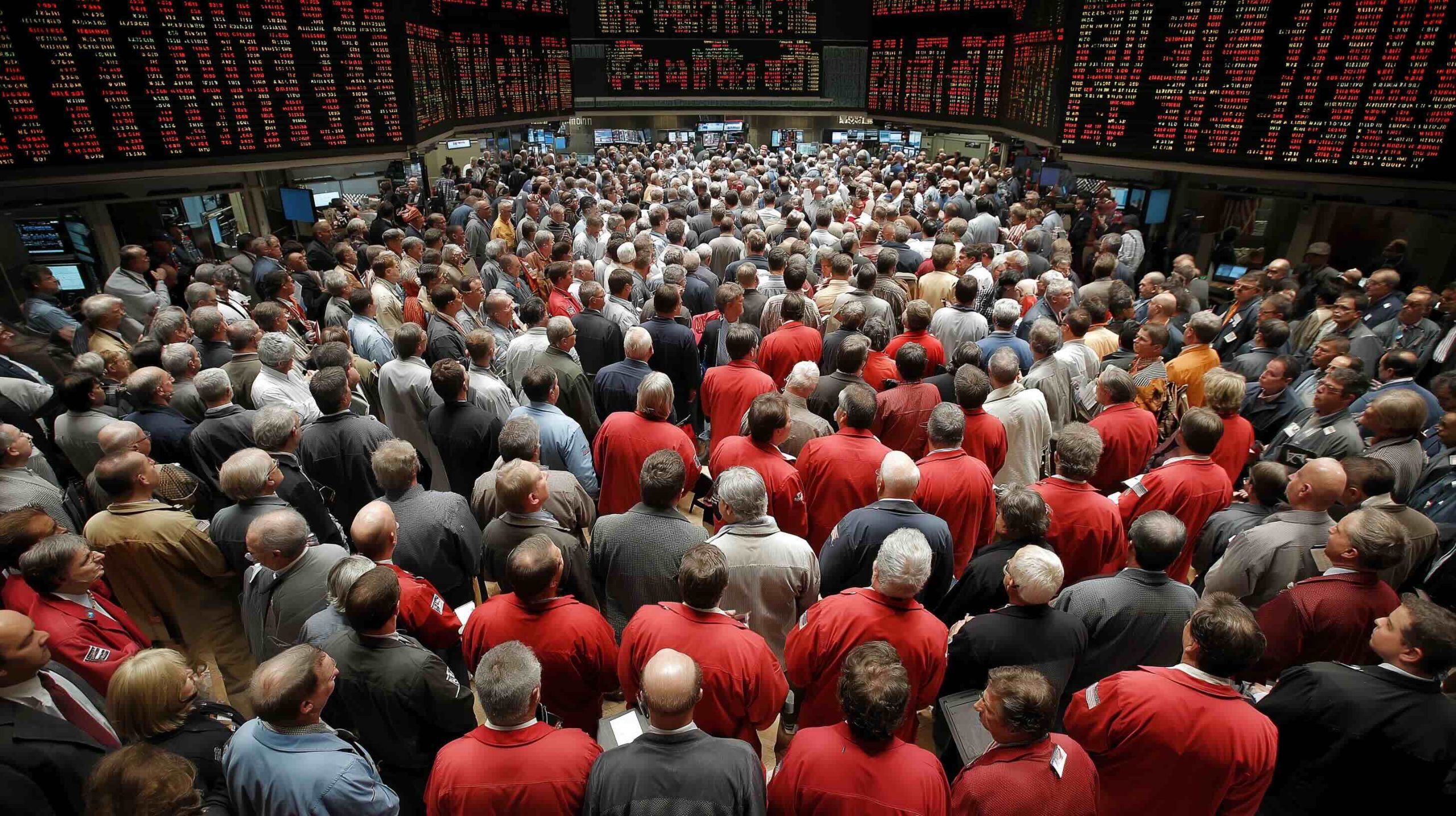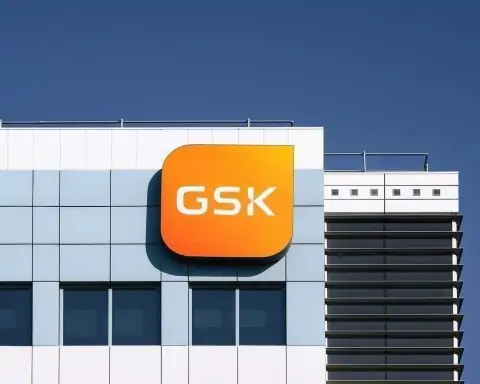- Nasdaq at All-Time High: U.S. stocks roared to record levels this week, with the tech-heavy Nasdaq Composite up nearly 1.4% on Monday alone amid a broad AI-fueled rally and hopes of a Federal Reserve rate cut [1].
- Nvidia’s Historic Milestone: Chipmaker Nvidia (NVDA) jumped ~5% to fresh highs, nearing an unprecedented $5 trillion market cap after CEO Jensen Huang revealed a staggering $500 billion in new AI chip orders and plans for seven government supercomputers [2].
- Mega-Caps Soar Pre-Earnings:Microsoft (MSFT) stock leapt to record territory (market cap >$4 trillion), and Alphabet (GOOGL) neared $3 trillion on rebounding ad/cloud growth, as both report earnings with ~13–15% revenue gains expected [3]. Apple (AAPL) hit all-time highs (~$260/share) on booming iPhone 17 demand, flirting with $4 trillion valuation [4].
- Meta & Amazon in Focus:Meta Platforms (META) shares trade near record levels (mid-$700s, +25% YTD) ahead of Q3 results, with analysts predicting ~21–23% revenue growth fueled by AI-driven ads [5]. Amazon (AMZN) – lagging at +3% YTD – aims to reignite momentum as it reports Q3 sales (forecast ~$178 billion, +12%) and a robust holiday outlook, led by e-commerce and cloud gains [6] [7].
- Fed Cut & Trade Optimism: The Fed is widely expected to cut interest rates by 0.25% today – its first rate reduction of 2025 – after cooling inflation data [8]. Meanwhile, U.S.–China trade truce hopes (with President Trump meeting China’s Xi this week) have turbocharged market sentiment [9] [10], adding to the tech sector’s tailwinds.
Market Hits Record Highs on AI & Fed Tailwinds
Wall Street’s enthusiasm is palpable as major indices surged to all-time highs ahead of Big Tech earnings. The Nasdaq Composite and S&P 500 both notched record closes to start the week, powered by investors “clinging to the positives” of strong earnings, AI innovation and an imminent Fed rate cut [11] [12]. On Monday Oct. 27, the Nasdaq jumped about 1.9% to ~23,637 [13] [14], with heavyweight tech stocks leading the charge. Alphabet soared 3.6% that day after an analyst upgrade, helping the communication-services sector rally +2.3% [15] [16]. Chipmakers also ripped higher – Qualcomm spiked 11% after unveiling new AI chips [17], and industry leader Nvidia rose another 2.8%, providing the single biggest boost to the S&P 500 [18] [19]. Even Tesla gained over 4% on optimism around U.S.-China trade talks [20], though some strategists warned its bounce may prove short-lived given Tesla’s still-rich valuation despite only a ~12% YTD stock rise [21] [22].
Multiple catalysts are feeding the euphoria. Traders are increasingly confident the Federal Reserve will ease policy, after a cooler-than-expected CPI inflation report “all but locked in” a quarter-point October rate cut [23]. Lower interest rates boost high-growth tech valuations, and the mere expectation of a Fed pivot has sent Treasury yields dipping and growth stocks soaring. At the same time, fears of a U.S.–China trade war escalation have flipped to relief. Reports of a framework tariff deal pushed global markets higher on Oct. 28, with the S&P 500 jumping 1% and Asian markets also climbing [24]. News that President Trump will meet China’s President Xi on Oct. 30 to hash out an agreement “clearly boosted sentiment,” fueling rallies in trade-sensitive tech and industrial shares [25]. “There is scope for investors to buy into positive news flow here,” noted Ross Hutchison of Zurich Insurance, as a U.S.–China truce appears in reach [26] [27]. This one-two punch of dovish Fed bets and trade optimism has injected a fresh dose of FOMO – the “fear of missing out” – into markets [28]. “It’s been a spectacular start to earnings season… justifying the rally,” said Carson Group’s Ryan Detrick, pointing out that roughly 87% of S&P 500 companies have beaten profit forecasts so far [29]. In short, the Nasdaq’s momentum is being underpinned by both improving fundamentals and hopes that macro risks (inflation, tariffs) are receding.
Nvidia’s stock price has skyrocketed over the past five years, far outpacing its fellow “Magnificent Seven” mega-cap peers amid the AI boom [30]. Analysts say this relentless surge – Nvidia is up ~50% in 2025 alone – reflects investor faith in explosive AI demand, though some warn such valuations leave “little room for disappointment.”
AI Boom Propels Tech Titans to Trillion-Dollar Heights
The AI gold rush of 2025 has firmly thrust America’s tech titans into unprecedented territory. Nowhere is this more evident than Nvidia, which by Oct. 29 was on the verge of becoming the world’s first $5 trillion company [31] [32]. Shares of the graphics-chip powerhouse surged another 3–5% this week after CEO Jensen Huang’s blockbuster announcement of $500 billion in AI chip orders and plans to build 7 AI supercomputers for the U.S. government [33]. This deluge of demand – on top of Nvidia’s 56% revenue jump last quarter – has transformed the once-niche GPU maker into the “backbone of the global AI industry,” as one analyst put it [34] [35]. Nvidia briefly hit the $4 trillion market cap milestone in July, and investors now appear ready to vault it past $5 trillion, surpassing even Apple as the world’s most valuable public company [36] [37]. “In many ways, everything that could have gone right for the firm has gone right,” said Pepperstone strategist Michael Brown, referring to Nvidia’s perfect storm of AI demand [38]. The company’s near-vertical ascent – its stock has rocketed over 1,400% in five years [39] – underscores how central AI hardware has become to market enthusiasm. (Notably, rivals are scrambling to catch up: earlier this month, AMD inked a major AI-chip deal with OpenAI, sending AMD stock up 34% in one day [40].)
Other “Magnificent Seven” giants are riding the same wave. Microsoft, long the world’s #2 company, saw its market capitalization blast past $4 trillion for the first time after revamping its partnership with OpenAI [41]. Investors cheered Microsoft’s new 27% stake in OpenAI and a $250 billion Azure cloud commitment from the startup [42], which removed uncertainty and affirmed Microsoft’s central role in the AI ecosystem. Microsoft’s stock jumped nearly 4% in a day on the news – hitting an intraday record around $553 – and is now up ~25% year-to-date (about +60% versus a year ago) [43]. The software giant reports earnings on Oct. 29, and analysts expect another strong quarter (~15% revenue growth to $75–76 billion) on the back of booming demand for its Azure cloud and AI services [44]. CEO Satya Nadella has called the AI shift “tectonic,” recently reshuffling Microsoft’s leadership to focus on “building the new frontier” in AI and cloud infrastructure [45]. That bold pivot – plus new AI-infused products like Windows Copilot assistants – has kept Wall Street bullish on Microsoft’s long-term prospects in the AI era.
Apple Inc. is also touching rarefied heights once again. The iPhone maker’s stock surged to all-time highs in late October (recently around $256–$260/share), putting Apple within a hair’s breadth of a $4 trillion valuation [46]. This rally is driven by a surprisingly strong iPhone 17 “supercycle”. Robust early sales of the latest iPhones – reportedly tracking 10–15% ahead of last year’s launch [47] – have stoked hopes that Apple’s growth engine is revving back up after a lull. Wedbush analyst Dan Ives says the iPhone 17 cycle could spark a “pent-up upgrade wave not seen in years,” given an aging base of over 300 million iPhones ripe for replacement [48]. Indeed, Apple’s June quarter already saw a return to growth (+10% revenue) and record $94 billion in sales [49]. Now, with fiscal Q4 results due Oct. 30, the company is projected to post its largest quarter ever – about $101 billion in revenue (+6–7% YoY) – thanks to the iPhone rebound and double-digit growth in high-margin services like the App Store [50]. That kind of steady (if not breakneck) growth, combined with Apple’s aggressive buybacks and fortress balance sheet, has reassured investors that the world’s biggest company still warrants a premium valuation. Apple’s stock had lagged some peers earlier in 2025 – it lacked an obvious AI “story” and was roughly flat through the summer [51] – but sentiment shifted as the company ramped up AI R&D and delivered hit products. Now, as Apple flirts with the once-unthinkable $4T mark, analysts like Dan Ives are raising targets (he sees $310 on the stock) and talking of a new “golden era of growth” ahead [52]. Still, not everyone is screaming “buy”: many on Wall Street rate Apple a hold or moderate buy, citing its lofty 30× earnings multiple and the need for continued innovation to justify further gains [53] [54].
Google parent Alphabet has likewise enjoyed a renaissance. After a digital-ad slump in 2022–23, Alphabet’s core ad business is firmly “back on a growth track” – and its stock price has responded with a 38% year-to-date surge to record highs [55] [56]. Both Alphabet share classes (GOOGL and GOOG) hit all-time highs above $255 in October, briefly valuing the company at over $3 trillion for the first time [57] [58]. In Q2, Google’s search ad revenue jumped +12% and YouTube ads +13%, and Q3 results (reporting Oct. 29) are expected to show ~13% sales growth (near $100 billion) with full-year profits up ~27% vs. 2024 [59]. New AI features like generative search and smarter YouTube recommendations have kept user engagement – and ad clicks – growing [60], while Google’s cloud division is booming (+32% YoY revenue last quarter) and finally profitable [61]. Alphabet has also splashed out on AI investments, announcing over $24 billion for new data centers this month across India and the U.S. [62]. With AI touching every part of its business (from Pixel phones to Gmail’s “Help Me Write” features), Google has convinced Wall Street that it’s “all in” on the AI revolution [63]. Roughly 79% of analysts rate Alphabet a buy, many recently hiking price targets into the $280–$310 range [64]. A big reason: Alphabet shook off a major legal overhang in September when a judge ruled Google won’t be broken up in an antitrust case – news that sent the stock up 9% in one day [65]. While regulators in Europe and the UK are still scrutinizing Google’s dominance (and even levying multi-billion-dollar fines) [66], the company has so far avoided any existential threats. With that cloud lifted and advertising growing again, Alphabet’s market cap has bloomed and could soon join Apple, Microsoft, and (perhaps) Nvidia in the exclusive $3–4 trillion club.
Meta Platforms is another tech giant riding high into earnings. Meta’s stock has climbed to the mid-$700s per share – near record territory – after a +25% run-up this year [67]. The Facebook and Instagram parent reports Q3 results after Wednesday’s close, and expectations are robust: about $49.5 billion in revenue (+21–23% YoY) and a hefty ~$6.7 EPS [68]. That growth is being driven by a rebound in digital advertising (as ad budgets recover post-pandemic) and Meta’s heavy investment in AI-driven content and ad targeting. CEO Mark Zuckerberg’s company has poured resources into AI – with $66–72 billion in capital expenditures planned this year for data centers and custom AI chips [69]. Those investments are enabling new products like the Meta AI chatbot (now 1 billion+ users) and more effective algorithms that boosted user engagement ~5–6% last quarter [70] [71]. Advertisers are benefiting too: AI recommendation models delivered 5% more conversions on Instagram and 3% more on Facebook in Q2 [72]. Wall Street has taken note – over 40 analysts rate META a buy, with some setting street-high targets up to $900 [73] [74]. Meta’s market cap is now approaching $2 trillion, a remarkable turnaround from the company’s challenges just two years ago. The key question is whether Reality Labs – Meta’s loss-making VR/AR division – and its colossal AI spending will pay off in future growth. Investors will be seeking reassurance that Meta’s “AI spend and ad growth” narrative can drive another rally, or at least sustain the current one. As JPMorgan’s analysts wrote, Meta remains a “top pick” thanks to its Reels video ads and AI-powered improvements [75], but the company must show that all those billions in AI capex are translating into real competitive advantages.
Lastly, Amazon.com stands out as a relative underperformer in this 2025 tech frenzy – but it, too, has big days ahead. Amazon’s stock has been range-bound for months, hovering in the low-$220s and barely above breakeven for the year (+~3% YTD) [76] [77] even as the Nasdaq soared ~20%. As a result, Amazon’s valuation (~$1.4–1.5 trillion) trails the other mega-caps, and it hasn’t approached the $2–3 trillion heights some peers have. Why the hesitation? Partly because Amazon’s growth, while solid, is no longer head-and-shoulders above the pack. The company’s Q3 results, due Oct. 30, are forecast to show ~11–13% revenue growth (≈$177–179 billion) – respectable but not spectacular [78]. Its all-important cloud unit, AWS, is expected to rebound to ~18% growth (after a period of slower expansion) [79]. And Amazon’s profit margins have actually been improving – operating margin hit ~13% last quarter, a multi-year high – thanks to cost cuts and efficiency moves [80]. Yet investors remain cautious, awaiting a clear catalyst to drive the next leg up. Amazon’s stock peaked at $242 back in February but then slumped amid a summer tech sell-off and hasn’t broken out since [81] [82]. The company has also faced regulatory and headline risks: it agreed to pay $2.5 billion in late September to settle an FTC case on Prime subscriptions [83] [84], removing one legal cloud, but still faces a broader antitrust suit over its marketplace dominance [85]. On the bright side, virtually all analysts remain bullish on Amazon (45 of 46 coverers rate it a “Buy”) with an average price target around $264 [86]. They argue the market is “underappreciating” Amazon’s strengths in cloud and advertising [87]. With the holiday shopping season approaching – Amazon is hiring 250,000 seasonal workers for the rush [88] – the e-commerce giant could see growth reaccelerate in Q4. CEO Andy Jassy also continues to “invest for growth” in AI, logistics and cloud capacity [89], even as he trims some corporate fat. The hope among bulls is that one strong earnings report or upbeat forecast might be the spark that finally lifts Amazon’s stock out of its 2025 rut [90]. For now, Amazon remains a sleeping giant compared to its high-flying peers – but one solid “beat-and-raise” quarter could quickly change that narrative.
Earnings Superweek: Big Tech Results Put Rally to the Test
With markets at records, the stage is set for a make-or-break earnings superweek from America’s tech elite. By Thursday night, five of the seven most valuable U.S. companies – Apple, Microsoft, Alphabet, Amazon, and Meta – will have reported quarterly results [91] [92]. Together these five alone are worth one-third of the entire S&P 500 [93], meaning their performance and guidance could sway the trajectory of the whole market. Analysts are generally predicting healthy (if not eye-popping) growth from the group. As one report noted, the numbers should be “solid but not stratospheric” – reflecting the tech sector’s maturation [94]. For example, Microsoft’s revenue is expected to rise ~15% (with Azure cloud +∼38%), Alphabet around +13%, and Amazon +12%, while Apple’s and Meta’s growth rates are in the mid-to-high single digits and low 20s respectively [95] [96]. These are strong results by any normal standard – after all, S&P 500 earnings overall are up ~10.5% this quarter [97] – but they also indicate that the era of hyper-growth in Big Tech has moderated. The bar has been set high by this year’s stock run-up, and any disappointment or cautious outlook could trigger a pullback in these richly valued names [98] [99].
Investors are thus laser-focused not just on the headline numbers, but on what executives say about the road ahead. “The commentary provided by executives will critically frame how far – and how confidently – the market can chase the AI story into 2026,” observed AvaTrade’s chief market analyst, Kate Leaman [100]. In other words, beyond Q3 figures, Wall Street is craving validation of the AI-fueled thesis that has driven these stocks to the stratosphere. As Wells Fargo strategist Scott Wren explained, with five of the “Mag Seven” reporting this week, the market expects to hear confirmation that all this AI spending is yielding real revenue and profit growth [101]. Any signals on cloud demand, AI product adoption, or margin impacts from AI investments will be parsed closely. Microsoft and Google will be scrutinized for their cloud growth rates (Azure and Google Cloud) as businesses increasingly deploy AI workloads. Meta will face questions on whether AI improvements can keep boosting ad growth – and how its spending on the metaverse and AI labs will affect profitability. For Apple, investors will want to know if the iPhone 17 strength is sustainable and whether the company has bigger AI ambitions (like the hinted “Apple GPT” in development). Amazon will be asked about AWS’s rebound and the consumer spending outlook into the holidays. In short, this week’s earnings are seen as a referendum on the 2025 tech rally – a check on whether the fundamentals (sales, earnings, guidance) can support the eye-watering valuations driven by AI excitement [102].
So far, earnings season has been robust. Out of 180 S&P 500 companies to report, over 78% have beaten forecasts, and aggregate earnings are on track to rise about 10.5% – well above earlier predictions [103]. This broad strength (from industrials to banks to healthcare) provides a reassuring backdrop. Even some cyclical bellwethers are signaling resilience: for instance, Caterpillar crushed profit estimates this week, sending its stock up 4% [104] [105]. And in tech, results outside the Magnificent Seven have largely impressed – chip-equipment maker Teradyne just jumped 22% after issuing bullish revenue guidance and naming a new CFO [106], while data storage firm Seagate climbed 6.5% on an upbeat outlook [107]. These positive surprises suggest corporate America is handling the high-rate environment better than feared, which bodes well for giants like Apple and Amazon that report last. However, the real tests come with the mega-cap earnings calls. Traders will be watching for any cracks in the AI narrative or cautious notes about next year. Notably, tech CEOs face the tricky task of justifying valuations: after adding an estimated $6 trillion in combined market cap this year [108], the burden is on Big Tech management to convince investors that growth (and margins) can keep rising to support those prices. Even a slight miss or soft guidance could spur knee-jerk selloffs, given how “priced for perfection” these stocks are after their massive rally [109].
One wildcard is the reaction to cost controls and buybacks. Thus far in 2025, many tech firms have quietly tightened belts – Amazon, Google, Meta all conducted layoffs or efficiency drives in the past year – which has boosted recent profits. If this quarter shows continued margin improvement (for example, Meta’s operating margin or Amazon’s costs coming down), that could further underpin the bullish case. Additionally, share repurchases remain a factor: Apple alone has been retiring billions worth of stock, helping boost its EPS. Such financial engineering could soften the blow if revenue growth is merely in-line. Still, nothing substitutes for top-line momentum in the eyes of investors. As Synovus investment manager Christopher Brown noted, the market is paying up for AI-related growth, so it needs evidence of “revenue and profits from AI coming through” as expected [110] [111]. In essence, this week’s flood of reports and conference calls will either confirm that the “AI revolution” is translating into tangible earnings – or prompt a rethink of the sky-high valuations if results underwhelm.
Fed on Deck: Rate Cut Imminent as Data Gaps Loom
While earnings steal the spotlight, the macroeconomic backdrop is also in flux – and largely in the market’s favor. The U.S. Federal Reserve is concluding a two-day policy meeting today (Oct. 29), and it is widely expected to announce a 0.25% interest rate cut, reducing the benchmark rate to roughly 3.75–4.00% [112]. Investors have “fully priced in” this move [113], which would mark the Fed’s first rate reduction since the pandemic recovery. Driving the decision is a mix of cooling inflation and some concerns about economic softening. The latest CPI report showed price increases slowing more than forecast in September, giving the Fed cover to ease up on its inflation fight [114]. At the same time, the labor market – while still relatively balanced – has shown hints of loosening. (Notably, an ongoing federal government shutdown has left the Fed “operating in a fog” with limited official data [115] [116]. Key reports like the September jobs numbers were delayed, forcing policymakers to rely on private indicators and their best judgment.) Nonetheless, Fed Chair Jerome Powell and colleagues signaled as far back as September that quarter-point cuts were likely at the Oct. and Dec. meetings [117]. Barring any last-minute surprises, they appear set to follow through. Traders are already looking ahead – futures markets show high odds of another 0.25% cut in December [118] [119], which would further unwind last year’s rate hikes and potentially give stocks another boost.
All eyes will be on the Fed’s 2 p.m. statement and Powell’s press conference for clues about the path forward. One key issue is whether the Fed will also signal an end to its “quantitative tightening” program – i.e. stop shrinking its balance sheet – which could inject additional liquidity into markets [120]. Another is the level of consensus or discord among Fed officials. Some policy hawks might dissent, arguing it’s premature to ease given core inflation is still above 3%. Others, like Fed Governor Stephen Miran (currently on leave to the White House), have even advocated for a larger half-point cut to jolt the economy [121]. Powell will have to navigate these differing views and communicate a coherent message. Market participants expect him to emphasize that the Fed is being cautious and data-dependent, not necessarily embarking on a rapid cutting cycle. The wildcard is the government shutdown, now nearly a month old, which has halted federal economic reports. If the shutdown (stemming from budget gridlock in Washington) continues, the Fed will lack hard data on jobs, spending, etc. In that case, Powell may lean even more on business surveys and anecdotes – many of which, so far, suggest a mild slowdown but no alarm bells.
For tech investors, the Fed’s dovish turn has been largely a positive story: lower rates mean lower discount rates on future earnings, boosting high-P/E growth stocks. Indeed, the mere anticipation of rate cuts has helped push the Nasdaq up in recent weeks [122]. But there’s a flip side – why the Fed is cutting also matters. If it’s mainly due to comforting inflation trends (which is the current narrative, with CPI easing to ~3% and wage growth cooling), that’s a sweet spot. If, however, the Fed hints at deeper worries (e.g. credit tightening, consumer weakness), that could spook markets. So far, there’s scant evidence of a hard landing: U.S. GDP for Q3 (due out this week) is expected to show solid growth, and corporate earnings are beating estimates across the board. Still, Powell’s tone will be parsed: any hint that the economy is weaker than thought – or conversely, any suggestion that the Fed might pause on further cuts if inflation perks back up – could cause volatility. In short, the Fed’s messaging will walk a tightrope between celebrating progress on inflation and acknowledging uncertainty ahead.
Beyond the Fed, global macro factors are also influencing the Nasdaq’s backdrop. The tentative U.S.–China trade détente has been a notable tailwind: reports indicate President Trump struck a deal with South Korea this week and is “optimistic” about reaching an accord with China’s Xi Jinping in talks set for Thursday in Busan [123]. Simply put, markets love the prospect of reduced tariffs and tension between the world’s two largest economies. Tech in particular would benefit – it’s an industry heavily exposed to China for both sales and supply chains. The mere rumor of a trade framework caused Chinese tech ADRs (like Alibaba and JD.com) to rally ~3–5% in New York trading [124]. Semiconductors and hardware stocks have also jumped, since a truce could ease export restrictions on chips. “Investors buy into any de-escalation in tensions,” Reuters noted, as even Bitcoin and crypto markets rose on the trade news [125] [126]. Of course, nothing is signed yet – and trade negotiations have fallen apart before – but at least for now, the geopolitical winds are blowing in a favorable direction for risk assets.
On the flip side, other geopolitical issues simmer in the background. The Middle East saw renewed conflict this month (a war involving Israel, which has been in headlines since 2024), and Russia-Ukraine fighting continues, with Ukraine launching drone strikes on Russian oil facilities. Those events have intermittently driven oil prices higher and boosted safe-haven assets like gold [127] [128]. In late September, gold actually hit a record ~$3,840/oz amid global uncertainty and rate-cut bets [129]. However, so far these shocks haven’t derailed the U.S. equity rally – in part because investors believe they’re contained and in part because any economic drag (like higher oil) is offset by the Fed’s easier stance. As HSBC strategists pointed out, even a U.S. government shutdown historically caused only “short-lived” market dips [130] [131]. Thus, while traders remain mindful of overseas risks and Washington dysfunction, the focus has stayed squarely on AI, earnings, and the Fed as the main market drivers.
Outlook: Can the Tech Rally Run Keep Going?
As October winds down, the Nasdaq’s dramatic run has put it on track for roughly a +19% gain in 2025 [132] – a testament to the market’s faith in technology’s future and the power of the AI boom. The big question: What’s next? Can the tech sector sustain this momentum into 2026, or is a breather (or pullback) inevitable? Bulls argue that unlike some past frenzies, this rally has been underpinned by genuine earnings strength and transformative tech trends. “Strong fundamentals – not just hype – are justifying the rally,” one analyst insisted, noting the broad beat rate on earnings and real revenue growth from AI and cloud services [133] [134]. Many also point out that Big Tech balance sheets are healthy, cash flows are huge, and these firms have room to keep investing through any macro slowdown. In other words, the leaders of the Nasdaq are better positioned than most to weather economic bumps, which could limit downside in their stocks.
However, voices of caution are growing louder as valuations stretch. JPMorgan CEO Jamie Dimon recently warned he’s “far more worried” about asset bubbles forming now, and sees risk of a “significant correction” if the AI euphoria fades or an exogenous shock hits [135]. Global regulators from the IMF to the Bank of England have also flagged that equity prices (especially in tech) may be “stretched” relative to fundamentals [136]. If growth were to disappoint – say, if cloud spending by enterprises slows or AI capex doesn’t translate into expected profits – these stocks could be vulnerable. For instance, even some bulls concede that Nvidia’s near-50× earnings multiple leaves little room for error [137]. A flat quarter or cautious forecast from Nvidia on Nov. 19 could reverberate across the market. Additionally, bond yields, while off recent highs, remain elevated compared to the ultra-low levels of 2020–21. Should economic data reaccelerate (or if inflation surprises on the upside later this year), yields might climb again and pressure richly valued tech shares. The Fed cutting rates now is good news, but it also implies the economy might be losing steam – something that could eventually temper corporate results (including for tech) heading into 2024.
For the moment, though, the prevailing mood is optimistic, if a bit uneasy. The Nasdaq’s streak of record highs suggests traders are betting that the current earnings parade will validate the market’s exuberance. Each of the big companies reporting has a chance to reinforce the bullish narrative: Microsoft and Google showcasing AI/cloud growth, Meta demonstrating ad resilience, Amazon proving the consumer is still spending, Apple confirming the iPhone cycle strength. If by week’s end those stories hold true, the Nasdaq could very well extend its gains – perhaps even ending 2025 at new all-time highs. Conversely, any notable disappointments or cautious guidance (especially if coupled with a hawkish tone from Powell) could trigger some profit-taking in November. As Magnusson Institute’s chief strategist quipped, “This week is the moment of truth: these five companies have powered this year’s rally, and their guidance on cloud and AI will tell us if the party continues or it’s time to take some chips off the table” [138] [139].
In summary, Nasdaq investors are navigating a pivotal crossroads. The ingredients that propelled tech stocks all year – surging AI demand, improving earnings, peaking interest rates, and easing geopolitical stress – are largely still in place as of October 29, 2025. That sets the stage for potentially more upside. But the next few days of news will be critical. A blend of strong earnings, a friendly Fed, and trade peace could ignite the next leg of the tech rally into the holiday season. On the other hand, any stumble or negative surprise might remind the market that trees don’t grow to the sky. As 2025’s final quarter begins, the world will be watching whether Silicon Valley’s biggest names can live up to their sky-high expectations – or whether this remarkable AI-fueled bull run finally takes a pause.
Sources: Nasdaq market data and earnings forecasts from TS² and Reuters [140] [141] [142] [143]; Nvidia and mega-cap stock milestones from Reuters [144] [145] and TS² [146] [147]; Federal Reserve and macro outlook from Reuters [148] [149] and TS² [150] [151]; analyst and expert commentary from TS², Reuters [152] [153] and other cited sources.
References
1. ts2.tech, 2. www.reuters.com, 3. ts2.tech, 4. ts2.tech, 5. ts2.tech, 6. ts2.tech, 7. ts2.tech, 8. ts2.tech, 9. ts2.tech, 10. ts2.tech, 11. ts2.tech, 12. ts2.tech, 13. www.reuters.com, 14. www.reuters.com, 15. www.reuters.com, 16. www.reuters.com, 17. www.reuters.com, 18. www.reuters.com, 19. www.reuters.com, 20. www.reuters.com, 21. ts2.tech, 22. www.reuters.com, 23. ts2.tech, 24. ts2.tech, 25. ts2.tech, 26. ts2.tech, 27. ts2.tech, 28. ts2.tech, 29. ts2.tech, 30. www.reuters.com, 31. www.reuters.com, 32. www.reuters.com, 33. www.reuters.com, 34. www.reuters.com, 35. www.reuters.com, 36. www.reuters.com, 37. www.reuters.com, 38. www.reuters.com, 39. www.reuters.com, 40. ts2.tech, 41. ts2.tech, 42. ts2.tech, 43. ts2.tech, 44. ts2.tech, 45. ts2.tech, 46. ts2.tech, 47. ts2.tech, 48. ts2.tech, 49. ts2.tech, 50. ts2.tech, 51. ts2.tech, 52. ts2.tech, 53. ts2.tech, 54. ts2.tech, 55. ts2.tech, 56. ts2.tech, 57. ts2.tech, 58. ts2.tech, 59. ts2.tech, 60. ts2.tech, 61. ts2.tech, 62. ts2.tech, 63. ts2.tech, 64. ts2.tech, 65. ts2.tech, 66. ts2.tech, 67. ts2.tech, 68. ts2.tech, 69. ts2.tech, 70. ts2.tech, 71. ts2.tech, 72. ts2.tech, 73. ts2.tech, 74. ts2.tech, 75. ts2.tech, 76. ts2.tech, 77. ts2.tech, 78. ts2.tech, 79. ts2.tech, 80. ts2.tech, 81. ts2.tech, 82. ts2.tech, 83. ts2.tech, 84. ts2.tech, 85. ts2.tech, 86. ts2.tech, 87. ts2.tech, 88. ts2.tech, 89. ts2.tech, 90. ts2.tech, 91. ts2.tech, 92. ts2.tech, 93. ts2.tech, 94. ts2.tech, 95. ts2.tech, 96. ts2.tech, 97. www.reuters.com, 98. ts2.tech, 99. ts2.tech, 100. www.reuters.com, 101. www.reuters.com, 102. ts2.tech, 103. www.reuters.com, 104. www.reuters.com, 105. www.reuters.com, 106. www.reuters.com, 107. www.reuters.com, 108. ts2.tech, 109. ts2.tech, 110. www.reuters.com, 111. www.reuters.com, 112. www.reuters.com, 113. www.reuters.com, 114. www.reuters.com, 115. www.reuters.com, 116. www.reuters.com, 117. www.reuters.com, 118. www.reuters.com, 119. www.reuters.com, 120. www.reuters.com, 121. www.reuters.com, 122. www.reuters.com, 123. www.reuters.com, 124. www.reuters.com, 125. ts2.tech, 126. ts2.tech, 127. ts2.tech, 128. ts2.tech, 129. ts2.tech, 130. ts2.tech, 131. ts2.tech, 132. ts2.tech, 133. ts2.tech, 134. ts2.tech, 135. ts2.tech, 136. ts2.tech, 137. ts2.tech, 138. ts2.tech, 139. ts2.tech, 140. ts2.tech, 141. ts2.tech, 142. www.reuters.com, 143. ts2.tech, 144. www.reuters.com, 145. www.reuters.com, 146. ts2.tech, 147. ts2.tech, 148. www.reuters.com, 149. www.reuters.com, 150. ts2.tech, 151. ts2.tech, 152. www.reuters.com, 153. ts2.tech









